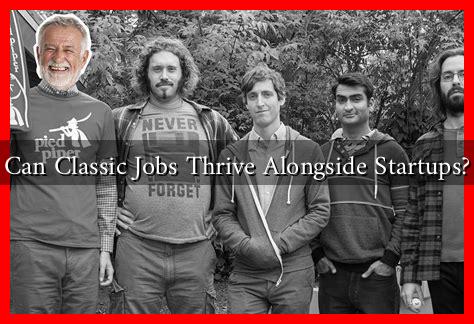-
Table of Contents
- Can Classic Jobs Thrive Alongside Startups?
- The Landscape of Employment: Classic Jobs vs. Startups
- Interdependence: How Classic Jobs and Startups Can Benefit Each Other
- Challenges Facing Classic Jobs in the Age of Startups
- Case Studies: Successful Integration of Classic Jobs and Startups
- The Future: A Hybrid Model?
- Conclusion: A Symbiotic Relationship
Can Classic Jobs Thrive Alongside Startups?
In today’s rapidly evolving job market, the rise of startups has sparked a debate about the future of traditional employment. As innovative companies disrupt established industries, many wonder whether classic jobs can coexist and thrive alongside these agile newcomers. This article explores the dynamics between classic jobs and startups, examining their interdependence, challenges, and opportunities.
The Landscape of Employment: Classic Jobs vs. Startups
Classic jobs, often characterized by stability, benefits, and structured environments, have long been the backbone of the economy. These roles typically include positions in sectors such as education, healthcare, manufacturing, and government. In contrast, startups are known for their flexibility, innovation, and risk-taking culture. They often operate in technology, e-commerce, and creative industries.
According to the U.S. Bureau of Labor Statistics, as of 2022, there were approximately 157 million employed individuals in the United States, with startups accounting for a significant portion of new job creation. In fact, the Kauffman Foundation reported that startups created an average of 3 million jobs annually over the past decade. This growth raises the question: can classic jobs and startups not only coexist but also benefit from each other?
Interdependence: How Classic Jobs and Startups Can Benefit Each Other
While classic jobs and startups may seem at odds, they can actually complement each other in several ways:
- Talent Pool: Startups often seek experienced professionals from traditional sectors to bring stability and expertise to their teams. This cross-pollination of talent can lead to innovative solutions and improved business practices.
- Collaboration Opportunities: Many startups partner with established companies to leverage their resources, networks, and market knowledge. This collaboration can lead to new products and services that benefit both parties.
- Skill Development: Classic jobs provide employees with valuable skills and experiences that can be beneficial in a startup environment. Conversely, startups can offer classic job employees exposure to cutting-edge technologies and methodologies.
Challenges Facing Classic Jobs in the Age of Startups
Despite the potential for synergy, classic jobs face several challenges in the startup-dominated landscape:
- Job Security: The rise of startups often comes with a perception of instability. Employees in classic jobs may feel threatened by the allure of startup culture, which can lead to talent attrition.
- Adapting to Change: Traditional companies may struggle to adapt to the fast-paced, innovative environment that startups thrive in. This resistance to change can hinder their competitiveness.
- Attracting Young Talent: Younger generations often gravitate towards startups for their dynamic work environments and perceived opportunities for growth. Classic jobs must find ways to appeal to this demographic.
Case Studies: Successful Integration of Classic Jobs and Startups
Several companies have successfully integrated classic job structures with startup methodologies, demonstrating that both can thrive together:
- IBM: Once a classic tech giant, IBM has embraced a startup mentality by investing in innovation labs and fostering a culture of entrepreneurship within the organization. This shift has allowed them to remain competitive in the tech landscape.
- General Electric (GE): GE has launched initiatives like GE Digital, which operates like a startup within the larger corporation. This approach has enabled them to innovate rapidly while leveraging their established resources.
The Future: A Hybrid Model?
As the job market continues to evolve, a hybrid model may emerge where classic jobs adopt startup-like agility and innovation. Companies can implement flexible work arrangements, encourage creative problem-solving, and invest in employee development to attract and retain talent.
Moreover, the rise of remote work has blurred the lines between traditional and startup environments, allowing for greater collaboration and innovation across sectors. According to a report by McKinsey, 58% of workers in the U.S. could work remotely at least one day a week, further emphasizing the need for adaptability in both classic and startup roles.
Conclusion: A Symbiotic Relationship
In conclusion, classic jobs and startups can not only coexist but also thrive together in a symbiotic relationship. By leveraging each other’s strengths, they can create a more dynamic and resilient job market. As traditional companies embrace innovation and startups seek stability, the future of work may very well be a blend of both worlds. The key takeaway is that adaptability, collaboration, and a willingness to learn from one another will be essential for success in this evolving landscape.
For further insights on the future of work and employment trends, you can explore resources from the U.S. Bureau of Labor Statistics and the Kauffman Foundation.

